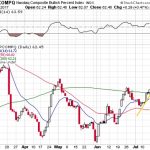
From last week:
“The seemingly “impervious” advance since the election last November, has had an interesting “stair step” pattern with each advance commencing from a breakout of a several month 3%-ish consolidation range. Furthermore, each advance then pushes to a 3-standard deviation extreme, black circles, of the 50-dma before beginning the next consolidation trading range.”

The last leg higher has been directly responsive to the ramp up in the political “marketing surge” surrounding “tax cuts and tax reform.” With the House having already passed their respective budget resolutions, late Thursday, the Senate passed a budget blueprint for the next fiscal year. With both of the “budget resolutions” in place, it was seen as clearing a hurdle to the goal of overhauling the tax code.
This is not new, of course, as the entire rally for the markets since the election has been driven by hopes of lower taxes, despite disaster, floods, fires and Central Bank threats of liquidity extraction.

The bulls are clearly in charge which keeps us allocated towards equity risk currently.
Do not be mistaken, this “rally” IS all about tax cuts. Despite many who are suggesting this has been a “rational rise” due to strong earnings growth, that is simply not the case as shown below. (I only use “reported earnings” which includes all the “bad stuff.” Any analysis using “operating earnings” is misleading.)

Since 2014, the stock market has risen (capital appreciation only) by 35% while reported earnings growth has risen by a whopping 2%. A 2% growth in earnings over the last three years hardly justifies a 33% premium over earnings.
Of course, even reported earnings is somewhat misleading due to the heavy use of share repurchases to artificially inflate reported earnings on a per share basis. However, corporate profits after tax give us a better idea of what profits actually were since that is the amount left over after those taxes were paid.

Again we see the same picture of a 32% premium over a 3% cumulative growth in corporate profits after tax. There is little justification to be found to support the idea that earnings growth is the main driver behind asset prices currently.
We can also use the data above to construct a valuation measure of price divided by corporate profits after tax. As with all valuation measures we have discussed as of late, and forward return expectations from such levels, the P/CPATAX ratio just hit the second highest level in history.

The reality, of course, is that investors are simply chasing asset prices higher as exuberance overtakes logic and their actions prove the case. According to data from FactSet, stock-based exchange-traded funds have seen nearly $16 billion in inflows over the past week, which represents an acceleration from recent positioning. Over the past month, about $31.3 billion has gone into stock-based ETFs. The chart below of data from ICI shows much of the same with monthly equity ETF inflows surging since the election.

The same is seen when we also add in equity mutual funds for a look at total equity asset flows.

Not surprisingly, those actions have been backed by their massive elevation in bullish sentiment.

As UMich noted:
“Consumer sentiment surged in early October, reaching its highest level since the start of 2004. The October gain was broadly shared, occurring among all age and income subgroups and across all partisan viewpoints.
There is an unmistakable sense among consumers that economic prospects are now about as ‘good as it gets.’”
Most hated bull market ever…hardly.
Historically speaking, you only witness such exuberance in the latter stages of an expansion, not the beginnings of one. The latest survey indicates that consumers do not anticipate an economic downturn anytime in the foreseeable future, which from a contrarian perspective may be a clear warning sign.













Leave A Comment